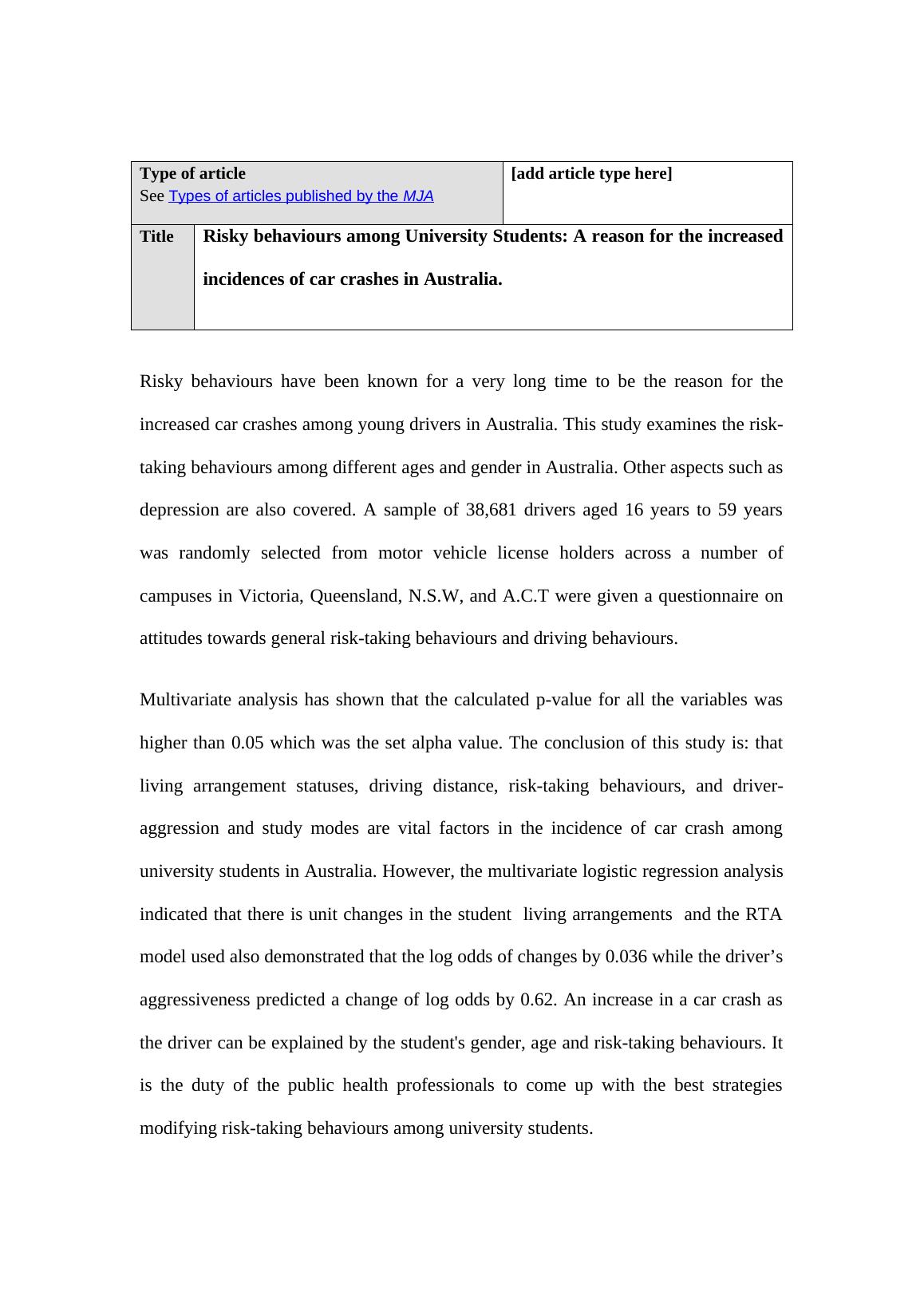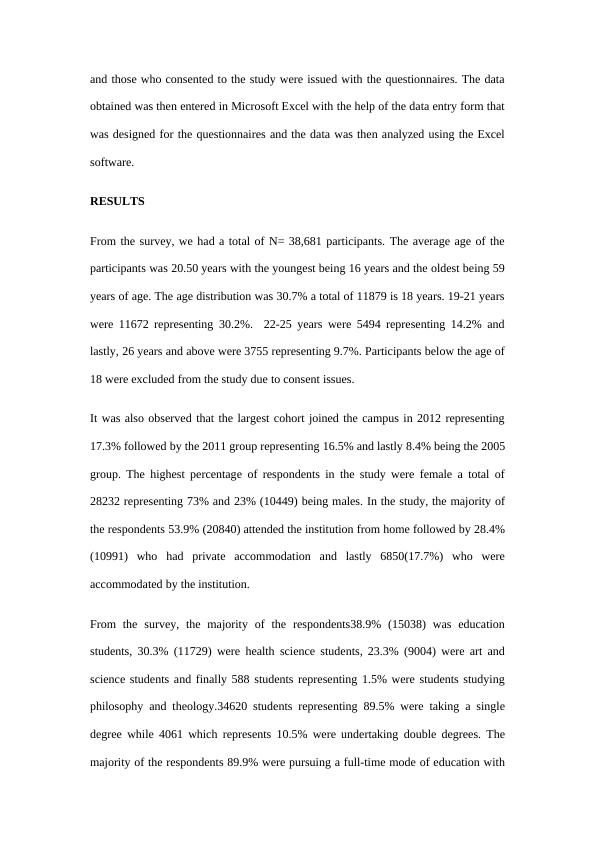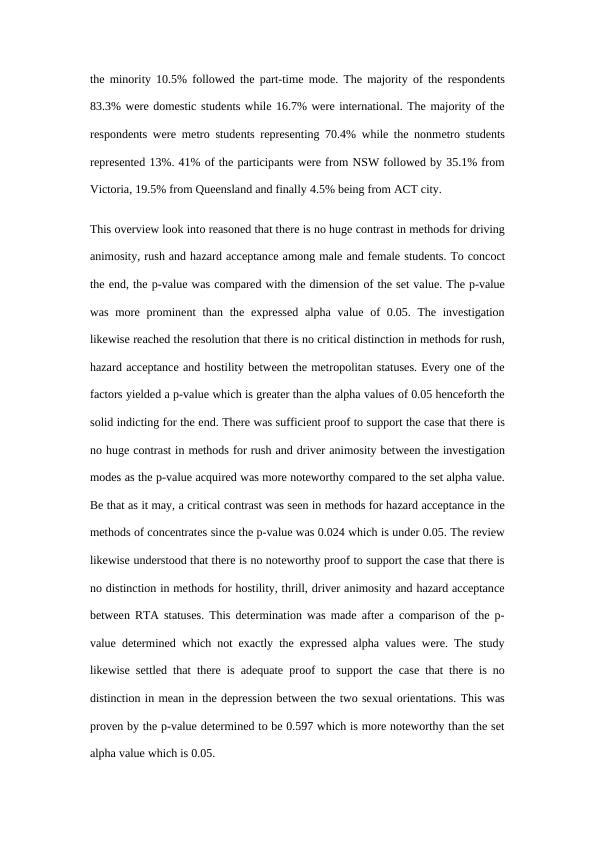Risky Behaviours Among University Students
Added on 2023-01-18
17 Pages2891 Words25 Views
Type of article
See Types of articles published by the MJA
[add article type here]
Title Risky behaviours among University Students: A reason for the increased
incidences of car crashes in Australia.
Risky behaviours have been known for a very long time to be the reason for the
increased car crashes among young drivers in Australia. This study examines the risk-
taking behaviours among different ages and gender in Australia. Other aspects such as
depression are also covered. A sample of 38,681 drivers aged 16 years to 59 years
was randomly selected from motor vehicle license holders across a number of
campuses in Victoria, Queensland, N.S.W, and A.C.T were given a questionnaire on
attitudes towards general risk-taking behaviours and driving behaviours.
Multivariate analysis has shown that the calculated p-value for all the variables was
higher than 0.05 which was the set alpha value. The conclusion of this study is: that
living arrangement statuses, driving distance, risk-taking behaviours, and driver-
aggression and study modes are vital factors in the incidence of car crash among
university students in Australia. However, the multivariate logistic regression analysis
indicated that there is unit changes in the student living arrangements and the RTA
model used also demonstrated that the log odds of changes by 0.036 while the driver’s
aggressiveness predicted a change of log odds by 0.62. An increase in a car crash as
the driver can be explained by the student's gender, age and risk-taking behaviours. It
is the duty of the public health professionals to come up with the best strategies
modifying risk-taking behaviours among university students.
See Types of articles published by the MJA
[add article type here]
Title Risky behaviours among University Students: A reason for the increased
incidences of car crashes in Australia.
Risky behaviours have been known for a very long time to be the reason for the
increased car crashes among young drivers in Australia. This study examines the risk-
taking behaviours among different ages and gender in Australia. Other aspects such as
depression are also covered. A sample of 38,681 drivers aged 16 years to 59 years
was randomly selected from motor vehicle license holders across a number of
campuses in Victoria, Queensland, N.S.W, and A.C.T were given a questionnaire on
attitudes towards general risk-taking behaviours and driving behaviours.
Multivariate analysis has shown that the calculated p-value for all the variables was
higher than 0.05 which was the set alpha value. The conclusion of this study is: that
living arrangement statuses, driving distance, risk-taking behaviours, and driver-
aggression and study modes are vital factors in the incidence of car crash among
university students in Australia. However, the multivariate logistic regression analysis
indicated that there is unit changes in the student living arrangements and the RTA
model used also demonstrated that the log odds of changes by 0.036 while the driver’s
aggressiveness predicted a change of log odds by 0.62. An increase in a car crash as
the driver can be explained by the student's gender, age and risk-taking behaviours. It
is the duty of the public health professionals to come up with the best strategies
modifying risk-taking behaviours among university students.

INTRODUCTION
More often than not cases of tragic car accidents have been recorded in Australia with
the victims being young males aged between 17-24 who are just 12.7% of motor
vehicle license holders yet account for 20.3% of the total road crashes (Bridie, 2018).
Over the years, motorcycle usage among young adults in Australia has seen
significant increase since 1998, where in 2007 the annual increase was 7% (Johnston
et al., 2008). Despite a large number of fatalities reported, a measure that has been
adopted to reduce the cases has not proven to be of much success calling for a shift on
other measures that could help reduce the cases. The focus needs to be shifted from
driver training and education to identifying risk-taking behaviors and the environment
surrounding the occurrence of these accidents.
A car accident statistics report of Australia in 2019 showed that males made up 72%
of all road fatalities between the years 2013-2019. It was realized that the males were
responsible for the crashes indicating a higher rate of risk-taking behaviors amongst
them compared to the females. The risk-taking behaviors included driving while
drunk, over speeding and the use of mobile phones while driving. However, no data
has lined any of these behaviors to the likely percentage of occurrence of the crashes.
The aim of this research paper is to examine how risk-taking behaviors and the likely
occurrence of a crash among Australian university students are correlated.
MATERIAL AND METHODS
Design and Setting
A longitudinal cohort study was carried out on a number of campuses across Victoria,
Queensland, N.S.W, and A.C.T. A sample of 38,681 students was randomly selected
More often than not cases of tragic car accidents have been recorded in Australia with
the victims being young males aged between 17-24 who are just 12.7% of motor
vehicle license holders yet account for 20.3% of the total road crashes (Bridie, 2018).
Over the years, motorcycle usage among young adults in Australia has seen
significant increase since 1998, where in 2007 the annual increase was 7% (Johnston
et al., 2008). Despite a large number of fatalities reported, a measure that has been
adopted to reduce the cases has not proven to be of much success calling for a shift on
other measures that could help reduce the cases. The focus needs to be shifted from
driver training and education to identifying risk-taking behaviors and the environment
surrounding the occurrence of these accidents.
A car accident statistics report of Australia in 2019 showed that males made up 72%
of all road fatalities between the years 2013-2019. It was realized that the males were
responsible for the crashes indicating a higher rate of risk-taking behaviors amongst
them compared to the females. The risk-taking behaviors included driving while
drunk, over speeding and the use of mobile phones while driving. However, no data
has lined any of these behaviors to the likely percentage of occurrence of the crashes.
The aim of this research paper is to examine how risk-taking behaviors and the likely
occurrence of a crash among Australian university students are correlated.
MATERIAL AND METHODS
Design and Setting
A longitudinal cohort study was carried out on a number of campuses across Victoria,
Queensland, N.S.W, and A.C.T. A sample of 38,681 students was randomly selected

and those who consented to the study were issued with the questionnaires. The data
obtained was then entered in Microsoft Excel with the help of the data entry form that
was designed for the questionnaires and the data was then analyzed using the Excel
software.
RESULTS
From the survey, we had a total of N= 38,681 participants. The average age of the
participants was 20.50 years with the youngest being 16 years and the oldest being 59
years of age. The age distribution was 30.7% a total of 11879 is 18 years. 19-21 years
were 11672 representing 30.2%. 22-25 years were 5494 representing 14.2% and
lastly, 26 years and above were 3755 representing 9.7%. Participants below the age of
18 were excluded from the study due to consent issues.
It was also observed that the largest cohort joined the campus in 2012 representing
17.3% followed by the 2011 group representing 16.5% and lastly 8.4% being the 2005
group. The highest percentage of respondents in the study were female a total of
28232 representing 73% and 23% (10449) being males. In the study, the majority of
the respondents 53.9% (20840) attended the institution from home followed by 28.4%
(10991) who had private accommodation and lastly 6850(17.7%) who were
accommodated by the institution.
From the survey, the majority of the respondents38.9% (15038) was education
students, 30.3% (11729) were health science students, 23.3% (9004) were art and
science students and finally 588 students representing 1.5% were students studying
philosophy and theology.34620 students representing 89.5% were taking a single
degree while 4061 which represents 10.5% were undertaking double degrees. The
majority of the respondents 89.9% were pursuing a full-time mode of education with
obtained was then entered in Microsoft Excel with the help of the data entry form that
was designed for the questionnaires and the data was then analyzed using the Excel
software.
RESULTS
From the survey, we had a total of N= 38,681 participants. The average age of the
participants was 20.50 years with the youngest being 16 years and the oldest being 59
years of age. The age distribution was 30.7% a total of 11879 is 18 years. 19-21 years
were 11672 representing 30.2%. 22-25 years were 5494 representing 14.2% and
lastly, 26 years and above were 3755 representing 9.7%. Participants below the age of
18 were excluded from the study due to consent issues.
It was also observed that the largest cohort joined the campus in 2012 representing
17.3% followed by the 2011 group representing 16.5% and lastly 8.4% being the 2005
group. The highest percentage of respondents in the study were female a total of
28232 representing 73% and 23% (10449) being males. In the study, the majority of
the respondents 53.9% (20840) attended the institution from home followed by 28.4%
(10991) who had private accommodation and lastly 6850(17.7%) who were
accommodated by the institution.
From the survey, the majority of the respondents38.9% (15038) was education
students, 30.3% (11729) were health science students, 23.3% (9004) were art and
science students and finally 588 students representing 1.5% were students studying
philosophy and theology.34620 students representing 89.5% were taking a single
degree while 4061 which represents 10.5% were undertaking double degrees. The
majority of the respondents 89.9% were pursuing a full-time mode of education with

the minority 10.5% followed the part-time mode. The majority of the respondents
83.3% were domestic students while 16.7% were international. The majority of the
respondents were metro students representing 70.4% while the nonmetro students
represented 13%. 41% of the participants were from NSW followed by 35.1% from
Victoria, 19.5% from Queensland and finally 4.5% being from ACT city.
This overview look into reasoned that there is no huge contrast in methods for driving
animosity, rush and hazard acceptance among male and female students. To concoct
the end, the p-value was compared with the dimension of the set value. The p-value
was more prominent than the expressed alpha value of 0.05. The investigation
likewise reached the resolution that there is no critical distinction in methods for rush,
hazard acceptance and hostility between the metropolitan statuses. Every one of the
factors yielded a p-value which is greater than the alpha values of 0.05 henceforth the
solid indicting for the end. There was sufficient proof to support the case that there is
no huge contrast in methods for rush and driver animosity between the investigation
modes as the p-value acquired was more noteworthy compared to the set alpha value.
Be that as it may, a critical contrast was seen in methods for hazard acceptance in the
methods of concentrates since the p-value was 0.024 which is under 0.05. The review
likewise understood that there is no noteworthy proof to support the case that there is
no distinction in methods for hostility, thrill, driver animosity and hazard acceptance
between RTA statuses. This determination was made after a comparison of the p-
value determined which not exactly the expressed alpha values were. The study
likewise settled that there is adequate proof to support the case that there is no
distinction in mean in the depression between the two sexual orientations. This was
proven by the p-value determined to be 0.597 which is more noteworthy than the set
alpha value which is 0.05.
83.3% were domestic students while 16.7% were international. The majority of the
respondents were metro students representing 70.4% while the nonmetro students
represented 13%. 41% of the participants were from NSW followed by 35.1% from
Victoria, 19.5% from Queensland and finally 4.5% being from ACT city.
This overview look into reasoned that there is no huge contrast in methods for driving
animosity, rush and hazard acceptance among male and female students. To concoct
the end, the p-value was compared with the dimension of the set value. The p-value
was more prominent than the expressed alpha value of 0.05. The investigation
likewise reached the resolution that there is no critical distinction in methods for rush,
hazard acceptance and hostility between the metropolitan statuses. Every one of the
factors yielded a p-value which is greater than the alpha values of 0.05 henceforth the
solid indicting for the end. There was sufficient proof to support the case that there is
no huge contrast in methods for rush and driver animosity between the investigation
modes as the p-value acquired was more noteworthy compared to the set alpha value.
Be that as it may, a critical contrast was seen in methods for hazard acceptance in the
methods of concentrates since the p-value was 0.024 which is under 0.05. The review
likewise understood that there is no noteworthy proof to support the case that there is
no distinction in methods for hostility, thrill, driver animosity and hazard acceptance
between RTA statuses. This determination was made after a comparison of the p-
value determined which not exactly the expressed alpha values were. The study
likewise settled that there is adequate proof to support the case that there is no
distinction in mean in the depression between the two sexual orientations. This was
proven by the p-value determined to be 0.597 which is more noteworthy than the set
alpha value which is 0.05.

End of preview
Want to access all the pages? Upload your documents or become a member.
Related Documents
Physical Education Report 2022lg...
|7
|1220
|9
Medical Journal of Australia Manuscript submission template.lg...
|9
|2819
|72
A Self-Reported Longitudinal Study of Traffic Accidents Amongst University Students Caused Due to Driving Behaviourlg...
|10
|2359
|78
Analysis of an article on Do Young Drivers Become Safer After Being Involved in a Collision?lg...
|7
|1468
|364
Differences in Risk-Taking Behavior Among School Students in Australialg...
|12
|2235
|270
Texting and Driving in Young Adults in Australialg...
|13
|2774
|263
